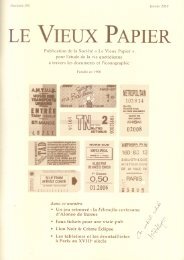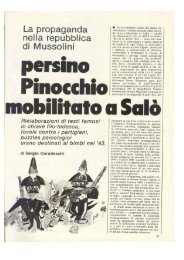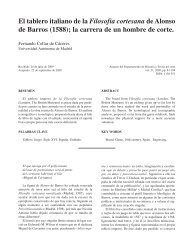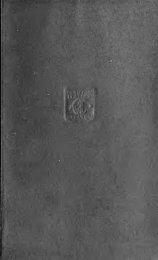Board games from the city of Vijayanagara (Hampi ... - Gioco dell'Oca.
Board games from the city of Vijayanagara (Hampi ... - Gioco dell'Oca.
Board games from the city of Vijayanagara (Hampi ... - Gioco dell'Oca.
Create successful ePaper yourself
Turn your PDF publications into a flip-book with our unique Google optimized e-Paper software.
38<br />
B OARD G AME S TUDIES 6, 2003<br />
state and a wise reign; but also in <strong>the</strong> interpretation <strong>of</strong> chess as a reflection <strong>of</strong> war, with<br />
an army <strong>of</strong> soldiers and <strong>of</strong>ficers under <strong>the</strong> command <strong>of</strong> <strong>the</strong> king. Games tables were not<br />
only pieces <strong>of</strong> utility furniture, many <strong>of</strong> <strong>the</strong>m were representative and not for use and<br />
served as bearers <strong>of</strong> symbols <strong>of</strong> power. Considering <strong>the</strong> connotation <strong>of</strong> chess with war,<br />
it seems ra<strong>the</strong>r logical that <strong>games</strong> tables for chess were combined with allegories <strong>of</strong> war.<br />
One very splendid example is a “<strong>games</strong> table with chained-up Turks” in <strong>the</strong> Residence<br />
in Munich (plates 1 and 1a [detail]). The tabletop is <strong>from</strong> Augsburg, and dates <strong>from</strong><br />
around 1670. The underframe was made in Munich around 1690. The table consists <strong>of</strong><br />
a tabletop with rich marquetry and an underframe with carved sculptures, which was<br />
made later than <strong>the</strong> tabletop, but most certainly directly planned as an underframe for<br />
this tabletop. The frame <strong>of</strong> <strong>the</strong> tabletop contains a board for chess/draughts and<br />
backgammon. The tabletop is supported by silver- and goldplated statues, at <strong>the</strong> two<br />
sides by two chained-up Turks, and in <strong>the</strong> middle by two eagles and various war trophies.<br />
The tabletop itself is decorated with rich marquetry on a ground <strong>of</strong> ebony and shows<br />
ornaments as well as exotic and native animals, birds, insects and flowers. Only <strong>the</strong> cartouche<br />
in <strong>the</strong> middle depicts war trophies.<br />
One long side <strong>of</strong> <strong>the</strong> frame is divided into two halves, one being a drawer. The o<strong>the</strong>r<br />
half can be opened by spring pressure like a flap and reveals two compartments which pull<br />
out. One is a draughts/chess and backgammon board, <strong>the</strong> o<strong>the</strong>r is a tray for draughtsmen<br />
and chess pieces. Once pulled out completely, <strong>the</strong> chess/backgammon board can be used<br />
for playing. Inlaid on a ground <strong>of</strong> Macassar ebony is a field for backgammon made <strong>of</strong> <strong>of</strong><br />
tortoiseshell and mo<strong>the</strong>r-<strong>of</strong>-pearl with ivory veins, <strong>the</strong> middle <strong>of</strong> this board contains a<br />
rhombic board for chess or draughts, inlaid with tortoiseshell and mo<strong>the</strong>r-<strong>of</strong>-pearl; each<br />
triangle is adorned by an inlaid animal <strong>of</strong> engraved mo<strong>the</strong>r-<strong>of</strong>-pearl: in <strong>the</strong> tortoiseshell<br />
spaces we find birds, in <strong>the</strong> o<strong>the</strong>r fields various animals <strong>from</strong> hares to deers. The triangles<br />
<strong>of</strong> <strong>the</strong> backgammon-board are shaped like obelisks, with turned peaks and curves. The war<br />
trophies allude to <strong>the</strong> fight <strong>of</strong> <strong>the</strong> electoral prince <strong>of</strong> Bavaria, Max Emanuel, on <strong>the</strong> side<br />
<strong>of</strong> Austria against <strong>the</strong> Turks. In this war, Max Emanuel had <strong>the</strong> only victories <strong>of</strong> his whole<br />
political life, in <strong>the</strong> years <strong>from</strong> 1683 to 1688.<br />
The tabletop was made earlier than <strong>the</strong> frame with its war symbols, already in <strong>the</strong><br />
times <strong>of</strong> Max Emanuel’s fa<strong>the</strong>r, Ferdinand Maria. The frame was made in <strong>the</strong> studio <strong>of</strong><br />
<strong>the</strong> court cabinet-makers in Munich, directly as part <strong>of</strong> <strong>the</strong> tabletop. At <strong>the</strong> time, it was<br />
not unusual that precious tabletops or o<strong>the</strong>r parts <strong>of</strong> furniture were ordered and made<br />
in <strong>the</strong> area which specialised in certain materials, and were <strong>the</strong>n completed in <strong>the</strong> court’s<br />
workshops. Only <strong>the</strong> war trophies on <strong>the</strong> underframe allude directly to a particular war,<br />
<strong>the</strong> trophies on <strong>the</strong> tabletop are ra<strong>the</strong>r general but prove that war allegories were combined<br />
with representative <strong>games</strong> tables. This table may seem an exception, but <strong>the</strong>re are<br />
a few more examples which combine <strong>games</strong> with war reminicences as well.<br />
A <strong>games</strong> table for chess, morris and backgammon in <strong>the</strong> Bavarian National Museum<br />
in Munich, top made in Augsburg, 1683/92, alludes to <strong>the</strong> same war, and most certainly<br />
was <strong>the</strong> property <strong>of</strong> Max Emanuel as well (plates 2 and 3). The table is rectangular and<br />
has a curved underframe which used to be foldable. The middle part <strong>of</strong> <strong>the</strong> tabletop can<br />
be turned up, on <strong>the</strong> underside are fields in marquetry for chess and morris, and in <strong>the</strong>







